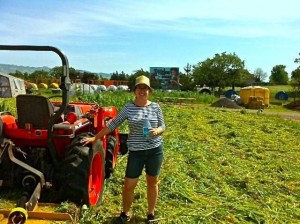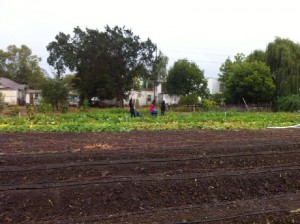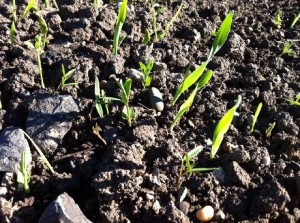How to Prepare Your Garden For Fall
I know I’m not the only one delighting in the first signs of fall in the air. Leaves on the ground are suddenly crisp and golden, the breeze has taken on a chill, and winter squash is appearing at farmers markets! Although many of us are still harvesting the last of our summer tomatoes and squash, it’s important that we think ahead to our fall and winter gardens and get going on them now.

Out With The Old
It’s time to glean the rest of your annual summer crops off of their plants, and get those babies out of there. There’s nothing I find more satisfying than ripping huge tomato plants out of the ground in October, feeling proud and satisfied that they have provided so much fruit for our community all summer long.
In order to successfully prepare your garden for fall, it’s important that you think about what you’re going to do with all that old plant debris You can compost much debris, or chop it up and mix it back into your soil with a shovel. BUT if you have diseased plants or weeds that have set seed – that is – grown big and tall and grown their own seeds that will soon fly off into your soil – it’s a good idea to get that stuff off of your property via your green bin. If you have hot and active compost piles, the composting process can kill off some of those pathogens and weeds, but if not, best leave it to the professionals.
Turning Over Garden Beds
Now that your garden beds are cleared of old plant matter, you should feed your soil with some fresh compost in order to prepare your garden for fall planting. I like to always work it into the top foot or so of topsoil, and sprinkle some on top for good measure. The act of mixing this compost into the soil with a digging fork will also help cultivate your soil for your new fall plants, creating air space and lightening up any compaction that has occurred during the season.

In With The New, Fall Vegetable Gardens
There are many great food crops you can still get in the ground, pots, or raised beds. It’s important to get them in soon, however, because most of their growth will occur before Thanksgiving when sunlight is still abundant and days are long. When your plants are sized up – that is, big and mature – , your chilly winter soil will serve as storage more than anything, holding your plants for you while you continue to pick off of them.
Let’s talk about what crops you can still get in the ground for a fall vegetable garden. We’ll begin with what you can ‘direct sow’ – that is, plant as seeds in the ground. Below is a list of some of my favorite crops to direct sow for a fall garden.
Seeds to Sow In The Ground For A Fall Garden
- Fava beans
- Asian greens
- Spinach
- Radishes
- Shallots
- Garlic
Many crops will simply grow better and stronger this way, as you avoid ‘transplant shock’ which can set the plans back a week or more in its growth. And many plants really don’t perform well after having their roots disturbed.
Then there are the crops that you can still transplant into the garden at this time, either by buying starts from a local nursery, or by starting them in trays yourself (for those of you who were thinking ahead and did this a month ago).
Tranplants to Get In The Ground For A Fall Garden
- Onions
- Kale
- Broccoli
- Lettuce
- Endive
Fall Crop Care
Fall and winter gardens require a bit of different care than do summer gardens. It’s a great idea to invest in some floating row cover to place over your crops in the event of a hard freeze. I also find that many bugs, aphids in particular, really like my greens in the winter. So make sure to use preventative measures such as keeping the area clean of debris and fertilizing heavily with compost to ensure strong, resilient crops.
Consider Cover Crops
Cover crops are plants that you grow with the express purpose of feeding your soil. Instead of growing food crops for a season, you can plant cover crops. Cover cropping your soil or raised beds is one of the best things you can do to fix nitrogen in your soil, add organic matter, and break up compaction in your ground or raised beds.
Like many farmers, I choose a mix of bell beans, oats, vetch, peas and barley. I am to direct sow it into the ground at a rate of 50 lbs/’acre or 2 ounces for 100 square feet. In a home garden, this will look like a sprinkling of seeds each spaced about an inch apart, which you then cover lightly with soil. I am to sow mine by late October, but into November is just fine too. I let it grow big and tall, watering it a few times if I can and if we have another dry winter, and then turn it back into the soil in the spring. This is a great option for you to replenish all or part of your garden over the winter in place of growing some food crops.
Next time on the blog we’ll talk all about cover crops – the what, how, why, and when!









 Family
Family

